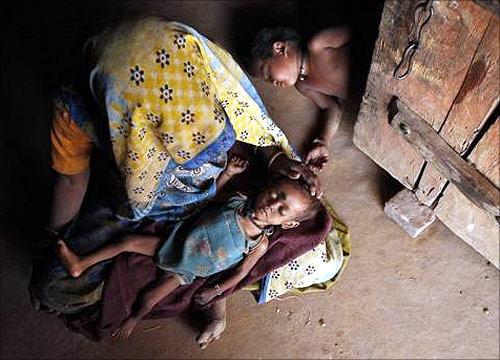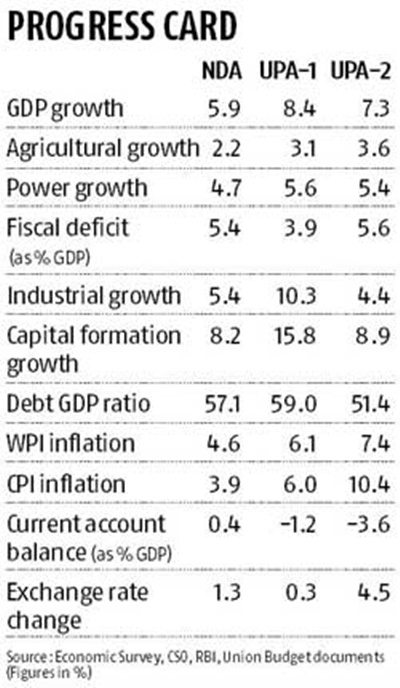Photographs: Reuters Shankar Acharya
UPA failed to undertake economic, social and administrative reforms to strengthen India's long-term development potential.
With the 15th Lok Sabha having ended and the next general elections two months away, it is timely to assess the Gandhi-Singh-led United Progressive Alliance (UPA) government's economic legacy after 10 years of its rule.
If one takes the decade of UPA rule as a whole and looks at a few key economic indicators, it is possible to claim, at first glance, that this government's achievements are good, perhaps even very good.
After all, overall economic growth has averaged 7.5 per cent per year, the fastest in any decade in India's history.
This rapid growth in gross domestic product (GDP) has raised average income, as reflected by per capita national income, by nearly 75 per cent in real, inflation-adjusted rupees.
This, too, is the highest decadal increase in average income in India's history.
...
UPA's economic legacy: Good, bad or ugly?
Photographs: Reuters
Turning to poverty, the latest official data show that the percentage of the population below the poverty line (Tendulkar definition) has dropped sharply from 37 per cent in 2004-05 to 22 per cent in 2011-12. It is the steepest decline in the poverty ratio ever seen in India.
Unfortunately, there are at least three broad sets of reasons why such a favourable assessment does not stand up to scrutiny. First, most of the high growth occurred in the first seven years up to 2010-11 (averaging 8.5 per cent a year), after which economic growth crashed, mainly because of the cumulation of bad economic policies pursued by the government.
In both the two most recent years, 2012-13 and 2013-14, official estimates show that GDP growth was below five per cent, the first time this has happened in two successive years in the last quarter of a century. Industrial production has plummeted to zero in the last two years.
Even the buoyant service sectors of the economy have slowed significantly. Inflation in consumer prices has jumped and remained high (nine to 11 per cent a year) in the last five years.
...
UPA's economic legacy: Good, bad or ugly?
Photographs: Reuters
The foreign trade and current account deficits rose steadily and dangerously since 2008-09 and triggered two bouts of sharp exchange rate depreciation (in 2011 and 2013).
The golden years of high growth with financial stability are long past.
Second, the UPA's economic policies were mediocre to start with and worsened increasingly as the decade evolved.
Indeed, the high growth and low inflation of the first five years were due mainly to the global economic boom of 2002-07 and the wide-ranging, productivity-enhancing economic reforms carried out prior to 2004.
The sole, important, growth-supporting UPA policy was the major fiscal consolidation achieved between 2004-05 and 2007-08.
And this major policy achievement was wholly squandered in 2008-09, through pre-election ramping up of major subsidies (oil, food and fertiliser), entitlement programmes (such as the Mahatma Gandhi National Rural Employment Guarantee scheme), government pay and other sops.
...
UPA's economic legacy: Good, bad or ugly?
Photographs: Reuters
The subsequent persistence with "fiscal populism", and the associated high fiscal and revenue deficits, kept inflation and interest rates high and helped widen the external account deficits to dangerous levels.
Among the other most noteworthy macro, sectoral and governance failures of the government were:
- the perpetuation of laws and policies, which hugely discouraged new employment in the organised sector, thus condemning over 95 per cent of the young new entrants to the labour force (the so-called demographic dividend) to low-paid, insecure occupations in the unorganised or informal sector of the economy;
- the growing recourse to "crony-capitalist" policies in key sectors such as telecom (the notorious, 2G spectrum allocation scam), mining (coal and iron ore), and land allocation, which have come to light since 2010 and their debilitating aftermaths continue to impact these and related sectors;
- the deliberate appreciation of the rupee in 2009-10 was ill-judged and contributed significantly to the subsequent widening of external deficits as both import substitution and exports were effectively discouraged;
...
UPA's economic legacy: Good, bad or ugly?
Photographs: Reuters
The sudden tightening of environmental standards (2010) and the inexplicable recourse to capricious and retrospective tax policies (2012), together with sectoral scams noted above, played havoc with the general investment and business climate and contributed to the sharp economic slowdown;
- the large increases in food procurement prices and a failing public distribution system turned the government into a massive hoarder of foodgrains and ramped up food inflation;
- even the success of inducing record investment in new power generation turned sour because of failures in co-ordinating fuel linkages (coal and gas) and weak energy pricing policies, leaving many thousands of costly megawatts of generating capacity idle or underutilised;
- the government's focus on entitlements and coverage, along with neglect of quality and accountability, meant that large parts of the massive systems of public education and health were seriously dysfunctional, though here the blame also falls on state governments.
...
UPA's economic legacy: Good, bad or ugly?
Photographs: Reuters
Third, the witch's brew of poor economic performance in recent years and a longer history of bad economic policies have combined to leave an unenviable array of economic vulnerabilities and challenges for whichever government takes office this summer.
They include:
- the failure to create reasonably decent jobs for the burgeoning young population of new job seekers (over 10 million each year), with profound adverse consequences for social and political stability;
- the extraordinary loss of growth momentum in the economy;
- the unprecedented stagnation in manufacturing output, despite the ready availability of cheap, low-skill labour;
- the continued scarcity of good-quality, efficient infrastructure (power, roads, ports, railways, water supply and sanitation);
- the heightened vulnerability of agriculture to water stress in large parts of the country;
- the widespread cancer of stalled, incomplete and delayed projects, which have reduced growth and burdened the banking sector with a mountain of dodgy loans that weigh heavily on the viability of many public sector banks and weaken overall financial stability;
...
UPA's economic legacy: Good, bad or ugly?
Photographs: Reuters
- The array of ill-conceived and inefficiently run entitlement programmes (such as rural employment guarantee, food security and education), which achieve limited welfare gains at the cost of enormous stress on fiscal capacity and foregone public investment;
- weak external finances, which are vulnerable to exogenous declines in capital inflows or to normalisation of recently increased gold duties and import restrictions, which have resurrected a rapidly growing trade in "hawala"-financed gold smuggling;
- a legacy of new lows in the quality of central governance (including economic governance), which have further weakened the country's rickety public administration in all areas.
Fundamentally, the decade of the UPA government failed to undertake economic, social and administrative reforms to strengthen India's long-term development potential, despite the golden opportunity offered by the years of high growth and investment. It is hard to resist the conclusion that the overall economic legacy is bad, if not ugly.
The writer is honorary professor at Icrier and former chief economic adviser to the government of India. Views are personal









article